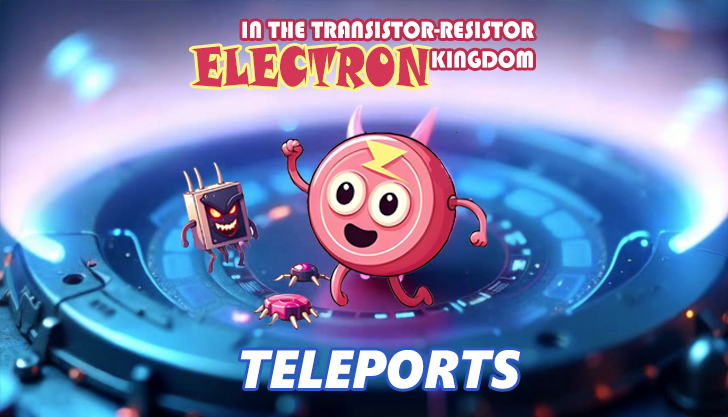Teleport as a device for moving matter in space and time
26 Oct 2024

This is a high-tech device that can instantly move a player from one point in the game world to another using plasma technology.
A teleporter is a device, mechanism, or phenomenon that allows for the instantaneous movement of material objects, living beings, or information from one point in space to another without passing through an intermediate path. In literature and science fiction, teleporters are used for instantaneous movement over various distances, from a few meters to intergalactic flights. Depending on the theoretical basis, teleportation can be presented as a scientific or magical phenomenon, or as a technology of the future.

The main theoretical concepts of teleportation:
Quantum teleportation is a real physical phenomenon based on the properties of quantum entanglement. In this process, information about the state of particles is transmitted instantly, but without physically moving objects. This opens up the possibility of creating a "teleportation" of information, but not the object itself.
Decomposition and recreation - in science fiction, the idea is often used that a teleporter disassembles an object into atoms or data, transmits them to a target point, where the object is then restored. This creates many ethical and technical issues, such as preserving identity or potential data loss.
Spatial distortions — teleporters may involve the use of wormholes or other space-time curvature phenomena. In this case, teleportation is accomplished by creating tunnels connecting two points and does not require moving in a straight line.
Temporal distortions — in some concepts, teleporters work not only as spatial transporters, but also as time ones, allowing travel to other points in time.
Classification of teleporters.
1. By the mechanism of movement
Quantum teleport — based on quantum entanglement; information about particles is transferred to the other side without physically moving objects.
Wormhole teleport — teleportation through space curvature, using wormholes between points in space-time.
Energy teleport — converting an object into energy, moving this energy to another location and restoring the object.
Through spatial windows — creating a window connecting two points in space; a person goes through a "door" and finds themselves in another place.
2. By operating principle
Portals are teleports that remain static and connect two points constantly. For example, portals for constant movement between two locations.
One-way teleports - work only in one direction, for example, for evacuation or one-way delivery.
Two-way teleports - can be used to move back and forth.
Portable teleports are small devices that create a temporary teleportation window, allowing you to transport yourself and objects over short distances.
3. By type of distance
Local teleports - for movement within a single building, planet or even galaxy, but within a limited range.
Interstellar teleports - movement between stars or planets over huge distances, possibly through wormholes or superluminal technologies.
Interspatial teleports - allow you to move between parallel dimensions, realities or timelines.
4. By type of transported object
Bioteleports - only for living beings. Adapted for the safe movement of biological structures.
Cargo teleporters - only for objects and cargo, without transporting living beings.
Universal teleporters - for moving any objects, including people, cargo and even energy.
5. By activation method
Manual teleporters - activated by the user through the interface, controller or manual trigger.
Automatic teleporters - activated under specified conditions, for example, when an object enters a certain area.
Intelligent teleporters - equipped with AI to analyze the surrounding conditions, optimal time and point of movement.
6. By stability
Stable teleporters - designed for repeated use without loss of quality.
Unstable teleporters - can be disposable, are destroyed after use or have limitations in accuracy and range.
Variable teleporters - the characteristics of which can depend on external conditions, such as energy, weather conditions or gravity.
7. As needed at the receiving point
Requiring a receiving device - the receiving equipment must be installed at the end point.
Not requiring a receiving device - can teleport objects "anywhere", but with a possible loss of accuracy.
8. By safety
Safe teleports - guarantee the safety of all data and the structure of the object.
Risk teleports - with possible deviations, damage or side effects, such as memory loss, errors in recovery.
9. By functionality
For time moving.
For space moving.
Mixed, allowing move both in space and in time.
Teleports often have mixed features described above - for example, a two-way interstellar teleport with a quantum mechanism that does not require a receiving device and is manually activated for travel in time and space.
Using and functions of teleports
Teleports are widespread in science fiction, games and fantasy. In the game Electron in the Transistor-Resistor Kingdom, for example, teleporters serve to speed up travel, create shortcuts, and improve gameplay. In science fiction, teleporters allow exploration of distant worlds or create new modes of travel, greatly expanding the capabilities of humanity.
The teleporter is a complex concept that combines many ideas about space, time, and matter, creating enormous potential for creativity and research in both artistic and theoretical fields.
Related games
Electron in the transistor-resistor kingdom
Game: Perform tasks and rest cool. 2524 people play!
Play gameRelated news
Online broadcast about the game Electron in the Transistor-R...
broadcast about the game Electron in the Transistor-Resistor Kingdom
Read morePlatforms in the game Electron in the Transistor-Resistor Ki...
Platforms are the basic game elements in the platformer genre. They are surfaces or objects on which the player can move...
Read moreSound Speakers Embedded into Trees
These sound trees can produce atmospheric sounds such as birdsong, wind, or wildlife sounds, creating a relaxing environ...
Read more




